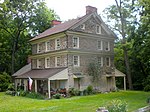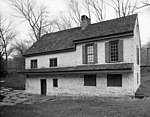Walnut Lane Bridge
1908 establishments in PennsylvaniaBridges completed in 1908Bridges in PhiladelphiaBridges on the National Register of Historic Places in PhiladelphiaConcrete bridges in Pennsylvania ... and 5 more
Historic American Engineering Record in PhiladelphiaOpen-spandrel deck arch bridges in the United StatesPhiladelphia Register of Historic PlacesRoad bridges on the National Register of Historic Places in PennsylvaniaWissahickon Valley Park

The Walnut Lane Bridge is a concrete arch bridge located in Northwest Philadelphia that connects the Germantown and Roxborough neighborhoods across the Wissahickon Creek in Fairmount Park. While drivers may cross the bridge too quickly to notice, the view from underneath the bridge has inspired many artists and writers, such as Christopher Morley. The design was copied from Pont Adolphe in Luxembourg.The Walnut Lane Bridge was added to the National Register of Historic Places in 1988.
Excerpt from the Wikipedia article Walnut Lane Bridge (License: CC BY-SA 3.0, Authors, Images).Walnut Lane Bridge
West Walnut Lane, Philadelphia
Geographical coordinates (GPS) Address External links Nearby Places Show on map
Geographical coordinates (GPS)
| Latitude | Longitude |
|---|---|
| N 40.032222222222 ° | E -75.199722222222 ° |
Address
Walnut Lane Bridge
West Walnut Lane
19119 Philadelphia
Pennsylvania, United States
Open on Google Maps







